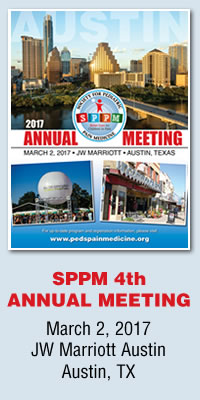Scratching the Surface of Prescription Opioids and Abuse
 By Anjana Kundu, MBBS, MD, DA, ABIHM and Rita Agarwal, MD, FAAP
By Anjana Kundu, MBBS, MD, DA, ABIHM and Rita Agarwal, MD, FAAP
What a great meeting we had in Colorado Springs, carefully planned between two spring snow storms. You will find reviews of both the SPPM meeting and the regional analgesia segment of the SPA meeting in this issue of the newsletter. My memory of how fabulous some of the talks were had faded a little, until I read about them in the reviews once again. Congratulations to Dr. Yuan-Chi Lin and the Education Committee for putting together such an informative and educational meeting.
Please read Dr. Kost-Byerly’s President’s Message in this issue. She describes the updates about the next cycle of elections and the nomination process. Also included in this edition is an excellent review of the current opioid crisis and the role of the FDA in helping to mitigate this by Dr. Rae Brown. The opioid “crisis” is an interesting phenomenon that many of us are getting blamed for; we are at the forefront of the efforts to understand what is going on and to try to develop viable solutions. Unfortunately, I don’t think most of us are the culprits. However, we DO shoulder the responsibility for being leaders and proactive participants in understanding and finding solutions.
Please indulge me (Rita) for a moment to share my own personal experience, both because it was certainly eye opening to me and because I hope it might be educational for others. This experience not only highlights the personal and “subjective” nature of the pain experience, but also the challenges faced by patients and providers in optimal and safe pain management.
The day after the SPA/AAP meeting ended in Colorado Springs, I went to Beaver Creek to go skiing with my family, where after almost 30 years of skiing, and 20+ years of living in Colorado, I fell and broke my tibia. After my ORIF I realized that there are really only four points on the pain scale and the rest of it doesn’t matter:
- I’m OK, this acetaminophen/ibuprofen (whatever) is enough.
- I wouldn’t mind a little something more.
- Umm, could you please hurry that up.
- NOW! NOW I need it NOW!
There were days when a “4”, a “6” or an “8” (on the 0-10 scale, not my modified scale) were just different. I had “6’s I could tolerate” and “6’s I couldn’t”. I was also really impressed with how little oxycodone I was sent home with. No opioid crisis here. I do not think that my experience is unique. I still think a lot of people are suffering after major injuries and surgery and that this may worsen in the future. I assumed that what I was prescribed would be all I needed. Fortunately, I was able to see my PCP shortly after running out of opioids and was able to get a refill for my persistent pain. I am not a wimp. I didn’t realize my leg was broken, and was joking with the ski patrol and my boys all the way into urgent care. No one thought I was hurt until the x-ray showed the tibial plateau and tibial shaft fracture.
So, who is out there prescribing these medications?
We all hear and read of nurse practitioners writing 15mg oxycodone for a back spasm, and plastic surgeons sending children home post op with a week's worth of opioids for ditzelectomies. We know that parents don’t give their children most of what they get prescribed and there’s no consensus on what we are supposed to do with leftover opioids. I am not sure what the solution is, but I suspect there isn’t just one solution. Presumably, it will take everyone’s efforts to find them: the CDC, FDA, state licensing boards and all of us as providers, parents and patients. We need to keep looking for, and availing ourselves of opportunities to, educate our colleagues, regarding too much and too little, alternatives and graded approaches to this multifaceted problem. The CDC’s new guidelines are worrisome in that the pendulum will swing back too far once again and people will still find other “self medicating” and unsafe sources. Pain sucks, and good pain treatment is both elusive and sublime. We need to keep looking for better medications, better treatments, better blocks, longer acting local anesthetics and better support for patients, parents and providers.
We encourage you to actively lead and participate in enhancing safe treatment of pain, educating your colleagues, and working with state and federal regulatory bodies. We also encourage you to engage in the SPPM social media sites such as Facebook, Twitter and the website. Share your experiences and articles, and engage your colleagues in discussions regarding interesting or challenging situations we all face and engaging the patients and caregivers who face the challenges of living with painful conditions. Our newest subsection under the Education tab on the SPPM website is dedicated to publication of case reports. We invite you to submit your unique case reports or you can write the PBLDs that you have submitted for the annual meetings as case reports.
We look forward to seeing your contributions. As always, if you have any questions or comments, feel free to contact us at:
Rita Agarwal, MD, FAAP
[email protected]Anjana Kundu, MBBS, MD, DA, ABIHM
[email protected]


